Nepal earthquake: Rescue effort intensifies
- Published
The BBC's Sanjoy Majumder says tent cities are springing up in Kathmandu
Relief efforts in Nepal are intensifying after more than 2,300 people were killed in the worst earthquake there in more than 80 years.
Rescue missions and aid material have started arriving in the country.
Seventeen people have been killed on Mt Everest by avalanches - the mountain's worst-ever disaster.
Meanwhile a powerful aftershock was felt on Sunday in Nepal, India and Bangladesh, and more avalanches were reported near Everest.
The 6.7-magnitude tremor, centred 60km (40 miles) east of Nepal's capital Kathmandu, sent people running in panic for open ground in the city.

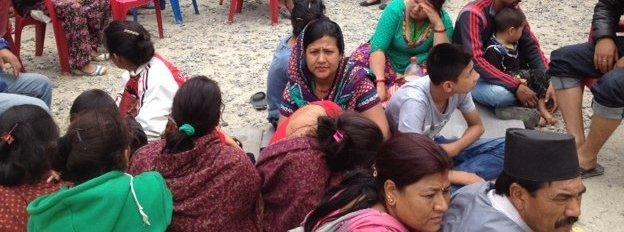
At the scene: By Surendra Phuyal, BBC News, Kathmandu
As military helicopters hovered over Kathmandu and ferried relief supplies to victims of the earthquake in western Nepal, search and rescue efforts were going on in at least five locations in Kathmandu.
Near the prime minister's official residence, two bulldozers scoured the rubble of a flattened four-storey house.
A bystander said it was the local tax office. The bodies of the four staff inside had been recovered minutes before.
As the search and road-clearing efforts got under way at noon, a major aftershock sent people into a panic again.
At a nearby open space, people were camped out fearing further tremors. They were short of food and water - clearly hoping and praying that the aftershocks would stop and things would be normal soon.

The death toll from the original earthquake on Saturday could rise, as the situation is unclear in remote areas which remain cut off or hard to access.
Many mountain roads are cracked or blocked by landslides.
Scores of bodies have been ferried to hospitals in Kathmandu, many of which are struggling to cope with the number of injured.
More than 700 have died in the capital alone.

Helicopters have begun ferrying injured people out of Everest Base Camp
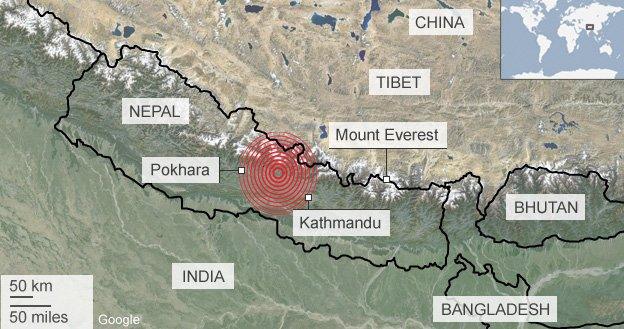
Tents have been set up in a parade ground in the city centre to house thousands of people displaced by the earthquake.
Medics are expecting a fresh influx of patients on Sunday as supplies run low.
Rescuers used their bare hands in places to dig for survivors still buried underneath piles of rubble and debris overnight on Saturday.
Army officer Santosh Nepal told the Reuters news agency that he and his soldiers had to dig a passage into a collapsed three-storey residential building in Kathmandu using pickaxes because bulldozers could not get through the ancient city's narrow streets.
"We believe there are still people trapped inside," he told Reuters.
The 7.8-magnitude quake struck an area of central Nepal between Kathmandu and the city of Pokhara on Saturday morning.
There were also victims in India, Bangladesh and in the Chinese region of Tibet.
It is the worst earthquake in Nepal since 1934, when some 8,500 people were killed.

Analysis - BBC Science correspondent Jonathan Amos
Large quakes are generally followed by a flurry of aftershocks, which tend to reduce in strength and frequency as time goes on.
As a rule of thumb, seismologists might expect to see at least one aftershock that measures roughly a magnitude less than the main shock. One of these, with a Magnitude of 6.6, was seen just half an hour after Saturday's main 7.8 event. Sunday has now experienced a further big aftershock of 6.7. From the early data, the tremor looks to have originated closer to the surface than Saturday's big shakers.
Although each step down on the magnitude scale is a 30-times drop in the energy released, Sunday's big aftershock will not have felt like that for those on the ground. And, of course, it may have toppled many already severely damaged buildings, adding to the difficulties of the rescue operation.
Nepal's architectural jewels destroyed

'Moment of crisis'
"We have launched a massive rescue and rehabilitation action plan and lots needs to be done," Information and Broadcasting Minister Minendra Rijal told Indian television.
"Our country is in a moment of crisis and we will require tremendous support and aid."

The rescue effort began in earnest in Kathmandu on Sunday morning
.
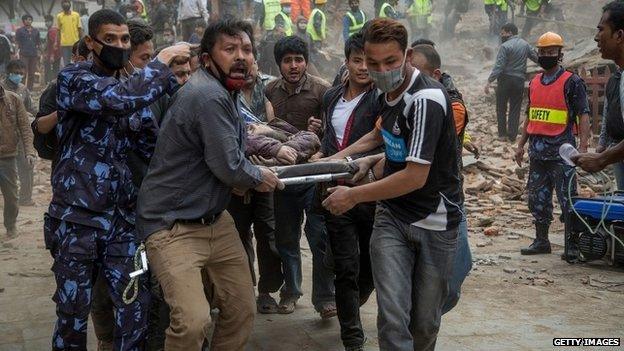
There are fears the death toll could rise yet further
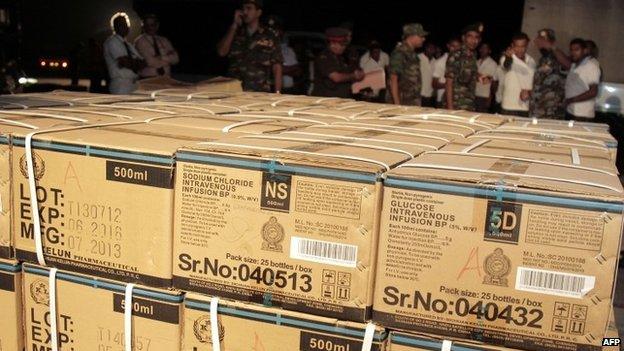
Aid - such as this material from Sri Lanka - has gradually started to arrive in Nepal
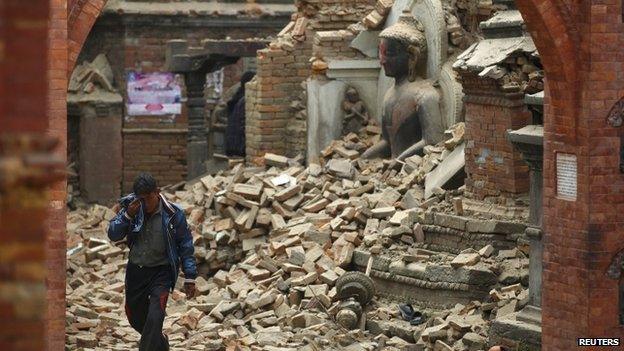
Historic buildings were badly damaged in the quake
Scores of people slept outside on Saturday night - braving wet and cold weather - either because their homes were destroyed or because they feared numerous aftershocks.
World leaders and global charities have offered emergency aid to Nepal, as the government grapples with the scale of the disaster.
India is at the forefront of the relief effort, offering help including helicopters which have been deployed to remote areas.
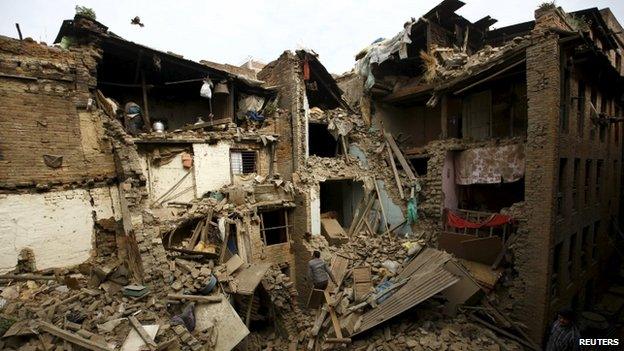
The historic city of Bhaktapur in the Kathmandu valley was also badly damaged
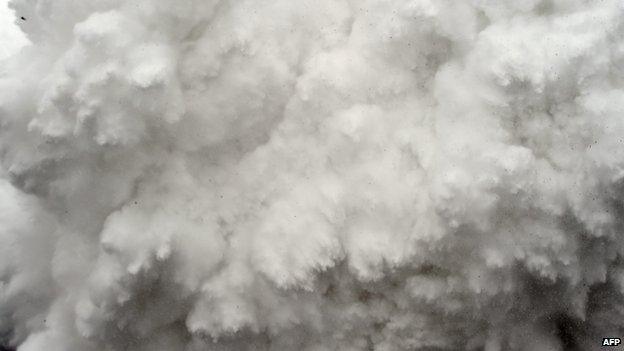
An avalanche was captured on camera moments before it descended on Everest Base Camp
The United States, Britain, China, Pakistan and European Union countries are among those who have pledged aid.
A number of international charities including Red Cross, Oxfam, Doctors Without Borders and Christian Aid are also sending teams to quake-hit areas.
Nepal earthquake thunderstorms
The International Federation of the Red Cross and Red Crescent Societies said it was especially worried about the fate of villages near the epicentre of the quake, some 80km (50 miles) from Kathmandu.
'Rubble and landslides'
The problems have been compounded by erratic internet and mobile phone communications.
British Red Cross spokeswoman Penny Sims said it was hard to get an accurate picture of what is going on.
"A lot of the roads are blocked, there's rubble, there's been landslides as well... So that is going to make the aid effort very difficult," she told the BBC.

People slept outside in Kathmandu on Saturday either because their homes were destroyed or because they feared aftershocks

People clear rubble in Kathmandu's Durbar Square
Foreign climbers and their Nepalese guides around Mt Everest were caught by the tremors and a huge avalanche.
As well as the 17 confirmed deaths, 61 people were injured when part of the base camp was buried under snow.
Helicopters trying to airlift the injured to Kathmandu were delayed by cloudy weather, but have now managed to rescue most of them.
Dan Fredinburg, a Google executive who described himself as an adventurer, was among the dead, Google confirmed.
Are you in the area? Are you affected by the earthquake? If it is safe to do so, you can share your story by emailing haveyoursay@bbc.co.uk, external
If you are willing to speak with a BBC journalist, please leave a contact number.
You can send a picture, video or message to our WhatsApp number +44 7525 900971
You can email your pictures, video or audio to us at yourpics@bbc.co.uk, external
You can upload pictures , external